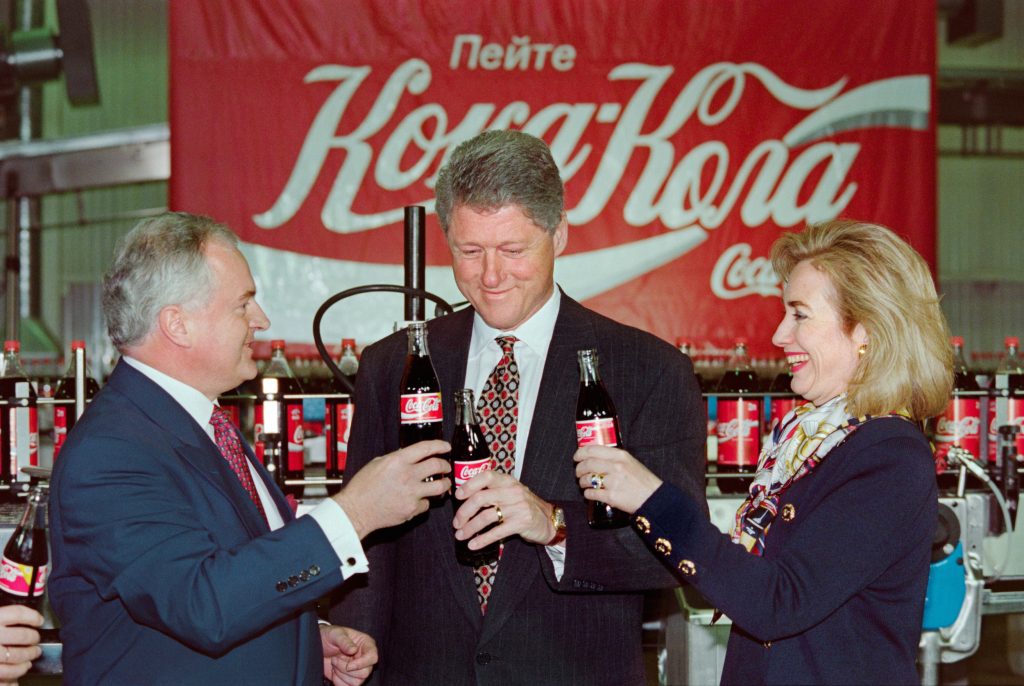By George Friedman
This is an election in which anything can happen. Nevertheless, for now at least, it appears that Hillary Clinton will be the next president of the United States. For the moment, we can turn away from the real issues of this world to the question of what Clinton’s foreign policy might look like if she wins. It is an important question, inasmuch as I was at a dinner last night where there were foreign diplomats, and they seemed oddly obsessed with the question.
To understand her foreign policy, it is important to understand the evolution of American strategy since the fall of the Soviet Union. Clinton is a creature of the beliefs, values and illusions that dominated American policy from 1991 until 2008. By understanding that world, we can understand Clinton’s core beliefs and then consider the extent to which they have evolved. Clinton represents the American and global consensus that emerged after the Cold War.

When the Soviet Union fell in 1991, there was a general assumption that the world of war, near war and distrust had been put behind us. This is normal when a global conflict ends. After Napoleon was defeated, the victorious powers met at the Congress of Vienna and decreed two things. The first was that the victorious anti-Napoleon coalition would continue in place and administer the peace. The second was that there were no fundamental differences among these coalition partners. The same assumptions were made after World War I in the League of Nations. After World War II, the United Nations was created, with the victorious coalition ensconced as the permanent members of the Security Council.
Great wars are won by coalitions and not individual states. There is an illusion that the common interests of these states during the war will endure to administer the peace. Leading powers will suppress new challengers and all that will be left is to maintain discipline in the system. War is obsolete and unnecessary, and the only thing that matters is enjoying the economic blessings that come with victory. These periods of comforting delusion can last for decades, as happened after the Napoleonic wars, or a few months, as happened after World War II.
This same thing happened after the end of the Cold War. The U.S. and President George H. W. Bush generally believed that the coalition that won the Cold War and the institutions that were created in the Cold War would govern the peace. NATO, the International Monetary Fund, the World Bank and others, as well as the coalition of anti-Soviet nations that had used these institutions, would create a perpetual peace, and history would come to a happy end.
There were only two tasks at hand. One was integrating the shattered Soviet Empire into the Western security and economic system. The other was managing unruly marginal nations. When Iraq invaded Kuwait, the United States marshalled a wide range of countries, including some former communist states, to punish the unruly Saddam Hussein, and the U.S. did this without concern about the Russian or Chinese reactions. The U.S. dominated a global coalition, the coalition was of one mind and minor irritants like Iraq would be dealt with as one.
This is the world that President Bill Clinton’s administration came into. It saw the world that George H. W. Bush had crafted as the world’s permanent condition and focused on further global economic and social integration. It extended Cold War institutions and engaged in intermittent military actions with primarily humanitarian goals (though not in every case) that were appropriate to coalition management. These were the only real reasons for having a military at this point.
Bush started this with the 1992 intervention in Somalia, where U.S. direct interests were minimal, but internal chaos had created a famine. Bill Clinton adopted this stance, sending forces to Haiti, to depose a singularly unpleasant government, and to Liberia. He bombed Iraq in Operation Desert Fox to prevent it from developing nuclear weapons, waged war against Serbia to prevent mass murder in Kosovo, and when a group called al-Qaida struck at U.S. embassies in East Africa and attacked the USS Cole, carried out retaliatory strikes of dubious effectiveness.
The view of the Clinton administration was that it led a worldwide coalition to manage a global consensus. None of these issues represented significant threats, but each had to be dealt with. Minor irritants might become more significant and with limited effort could be controlled.
These were side issues. The central issue was managing global economic growth. The 1990s were a period of large-scale development, and it was assumed that increased trade and international investment would perpetuate this growth and create a peaceful and prosperous world. Therefore, the primary interest of the Clinton administration was shaping the international economy. This was the strategic issue of the decade. The rest were secondary.
The Clinton administration did not see al-Qaida as a significant threat. It was another irritant, a terrorist group that could cause problems, but not change the direction of history. It also saw Russia as a closed issue. In spite of the catastrophic decade it had experienced, the Clinton administration did not believe Russia would emerge as a strategic challenger, but would rather settle into its role as a liberal democracy. As for China, increased global integration would simply increase its prosperity, and that prosperity would liberalize China.
Three beliefs were at work. The first was that we had entered an era in which nothing would disrupt economic growth. The second was that with economic growth, the world would be increasingly liberal. The third was that increased liberalism would lead to international harmony and no one would want to disrupt it. As a result, the rise of al-Qaida was not seen as the overriding issue, and extreme measures for destroying it were not used.
President George W. Bush accepted the core concepts behind this foreign policy. In an odd way, 9/11 did not change the foundations of American national strategy. As shocking as the 9/11 attacks were, the fight against al-Qaida, though central, did not change the fundamental assumptions about how the world worked. Economic growth and integration remained at the center, the struggle was built around a coalition and waging war in some way coincided with the concept of humanitarian interventions. The coalition became strained, to say the least. The war intensified and the humanitarian dimension collided with the reality of warfighting, but the beliefs remained that there were no peer powers threatening the United States and that global economic integration was not incompatible with an expanding war in the Islamic world.
There was another dimension. Humanitarianism and the belief in coalitions caused the United States to take a strange stance toward allies. The commitment to liberal democracy was as deep among liberal humanitarians as neoconservatives. Both would wage war for it, and both would demand allies adhere to it. Therefore, the coalition shrank not only because of defections, but equally from expulsions of nations the United States needed as allies but that did not measure up to its standards.
Much of this blew up in 2008. In August, the Russians went to war with Georgia, declaring that Russia had not taken the place in history that the Americans had intended. In September, Lehman Brothers collapsed. The world had ceased to be the post-Cold War world. There were fundamental politico-military challenges to the United States, not existential, but serious. The assumptions about perpetual prosperity weakened as interdependence spread the contagion of 2008 throughout the world.
The idea that China would become increasingly prosperous, increasingly liberal and disinterested in international conflict proved to be in error. Two newly confident rivals, Russia and China, challenged the American understanding of the world as it was bogged down in Iraq and Afghanistan. The challenge of the Islamic world spread, ranging from a more powerful and self-confident Turkey, to the Islamic State’s attempt to build a caliphate, to economic crisis in Saudi Arabia.
It was in this context that Hillary Clinton’s support of the intervention in Libya must be viewed, because it was the last gasp of the post-Cold War world. Moammar Gadhafi was clearly a thug and he might well have been about to carry out a massacre. Hillary Clinton accepted the notion that the United States, along with its coalition, had a moral obligation to prevent it. There have been theories that this was about oil or uranium or something else. It arose from a concept of the world that had eroded.
But this was the world after 9/11, and a corrupt tyrant might be better than what succeeded him. Destroying Gadhafi would not bring liberals to power, but trigger the rise of warring rival militias and opportunistic jihadists. The U.S. was able to destroy an enemy armed force, but nation-building – creating new societies on the wreckage of the old – was not what the U.S. was good at anymore. Humanitarian intervention was an illusion. The suffering after intervention was frequently worse than before. Most important, the divergence of U.S. forces into one theater weakened the U.S. in other theaters, and this was no longer a luxury the U.S. could afford, not in competition with Russian and Chinese power and interests.
Hillary Clinton is an interventionist, but her interventionism was shaped by Bill Clinton’s time in office, when each intervention was separate, none were linked to regional crises, and none affected the global balance. Driven partly by the concept of humanitarian intervention and partly by a misreading of American power to reshape countries, Libya resulted. Hillary Clinton’s support of the Libya intervention belies a worldview of a strategic reality that no longer existed. In the same sense, her economic understanding of the world pre-dated 2008. It was based on the assumption that economics and American values were more important than political and military matters and on the assumption that prosperity and integration were part of the same process.
When we think of Hillary Clinton as speaking for the establishment, it is not wrong, but it is insufficient. The establishment, which did brilliantly from the early 1980s until 2008, has failed to adjust to the new reality. Its ideology, business models and expectations of how the world works have not adapted to the new reality it had created. This is not surprising. It is the way things work.
Hillary Clinton gives every indication that she still thinks the post-Cold War is tattered but can be redeemed. Some people believed in the League of Nations and the Congress of Vienna long after they had ceased to exist in any meaningful way. As a tactician she may understand this, doing things differently on a case-by-case basis. But as a strategist, she does not see a strategic shift having taken place. It is difficult to abandon a world you thought permanent, even when that world is gone. And this will be the difficult part of a Hillary Clinton presidency. She is disciplined and coherent, but that turns out to be her trap.
To understand her dilemma, imagine a die-hard Cold Warrior trying to function in the post-Cold War world or someone committed to Versailles dealing with Hitler and Stalin. They would have no point of reference. Hillary Clinton’s challenge will be to adjust, strategically and in her soul, to this world. The reality of the world has shifted. Donald Trump has failed to understand the key reality of politics. Your enemies are at least as tough and ruthless as you are. The test for Hillary Clinton, if she wins, is whether she will understand that on the broadest level possible.








